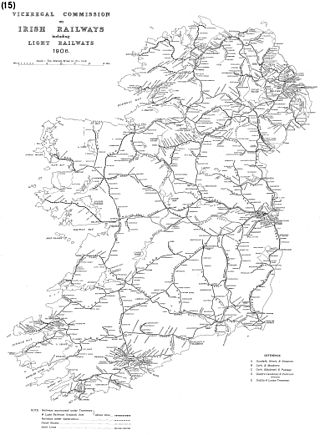A wide variety of steam locomotives have been used on Ireland's railways. This page lists most if not all those that have been used in the Republic of Ireland and Northern Ireland. Irish railways generally followed British practice in locomotive design.
The MGWR Class D-bogie were first 4-4-0 operated by the Midland Great Western Railway (MGWR) of Ireland. They were rebuilt from MGWR Class D 2-4-0 locomotives in 1900/01 with the intention to use them on the Dublin-Sligo mainline but they proved underpowered for this work and were allocated to more suitable work around Mayo and Achill. This led to their nicknames of Mayo Bogies or Achill Bogies. Following the merger of the MGWR into Great Southern Railways (GSR) they also became designated class 530 or D16.

The Midland Great Western Railway (MGWR) was the third largest Irish gauge railway company in Ireland. It was incorporated in 1845 and absorbed into the Great Southern Railways in 1924. At its peak the MGWR had a network of 538 miles (866 km), making it Ireland's third largest network after the Great Southern and Western Railway (GS&WR) and the Great Northern Railway of Ireland.
The MGWR Classes F, Fa and Fb are a group of similar classes of 0-6-0 steam locomotives of the Midland Great Western Railway of Ireland which were designed and built between 1921 and 1924. The locomotives could be used to handle goods and also for passenger traffic.
The Midland Great Western Railway (MGWR) C Class was a class of 4-4-0 locomotives designed and built at Broadstone by Edward Cusack between 1909 and 1915 using parts obtained from Kitson and Company. They replaced the earlier 7-12 class. The class survived through the Great Southern Railways (GSR) era from 1925-1944 and were withdrawn in the 1950s under Córas Iompair Éireann.

Dewrance & Co. Ltd was a manufacturer of engine and boiler accessories, such as pumps and gauges.

The MGWR Class K was a Midland Great Western Railway (MGWR) 2-4-0 designed by Martin Atock for passenger work and introduced from 1893. They replaced earlier MGWR Class D locomotives that carried the same namesand numbers. The class was also known as the Great Southern Railways (GSR) 650 G2 class.
Martin Atock, also formerly known as Martin Attock, was an English railway engineer, who is best known as the Locomotive Superintendent of the Midland Great Western Railway (MGWR) from 1872 to 1900.

Broadstone railway works or simply Broadstone or the Broadstone was the headquarters for mechanical engineering and rolling stock maintenance for Midland Great Western Railway (MGWR). The complex grew around the Dublin Broadstone railway terminus.
Henry Edward Cusack, or Edward Cusack as he was more commonly known, was a Locomotive Superintendent of the Midland Great Western Railway (MGWR).
William Herbert Morton was a British locomotive engineer who rose to the position of general manager of the Great Southern Railways (GSR) in Ireland. He previously held the chief engineering positions for GSR and Midland Great Western Railway (MGWR).

The Midland Great Western Railway (MGWR) A Class, later Inchicore Class D5, consisted of 6 4-4-0 express passenger locomotives built at Broadstone Works in the period 1902-1905. The largest express passenger locomotive in Ireland for a short while after introduction they were used on the MGWR's flagship services to Galway with most surviving until the 1950s albeit on less prestigious work.
The Midland Great Western Railway (MGWR) B Class 0-6-0 was a class of 4 locomotives built at North British Locomotive Company in 1904. In 1925 they were allocated Great Southern Railways (GSR) Class 646 / Inchicore Class J2.
The Great Southern Railways (GSR) 222/234 Classes 0-6-0 originated from 2 batches of 3 locomotives built for the Waterford, Limerick and Western Railway (WLWR) by Kitson with a contract payment dispute resulting in the final two members going to Midland Great Western Railway becoming MGWR Class W.
The Midland Great Western Railway (MGWR) Class P were an 0-6-0T tank locomotive designed by Martin Atock introduced in 1881 designed for shunting and banking round North Wall freight yard. After 1925 they became Great Southern Railways (GSR) class 614 / Inchicore class J10.
The Midland Great Western Railway (MGWR) Class H were an 0-6-0 locomotive bought in 1880 from Avonside Engine Company. After 1925 they became Great Southern Railways (GSR) class 619 / Inchicore class J6.

Midland Great Western Railway (MGWR) Classes 1,2,3,4,5 and 13 were 2-2-2 locomotives acquired over the period 1847-1862 serving the railway in its formative years.
Midland Great Western Railway (MGWR) Classes 6,8,10,11,17 and 18 were 2-4-0 locomotives introduced in the period 1852-1870. The 22 locomotives were spread across 6 different manufacturers and all were withdrawn in the decade between 1880 and 1890 though some donated parts to other builds at Broadstone Works.

The MGWR Class D were 2-4-0 steam locomotives built in batches from 1873 to 1887 for the Midland Great Western Railway (MGWR) of Ireland to a Martin Atock design. Numbering 39 at their peak they were the standard MGWR passenger locomotive of their era. Six of the class were rebuilt as 4-4-0.

Recess railway station was on the Midland Great Western Railway (MGWR) Clifden branch line from Galway and was situated in the heart of the Connemara tourism area in Ireland.









